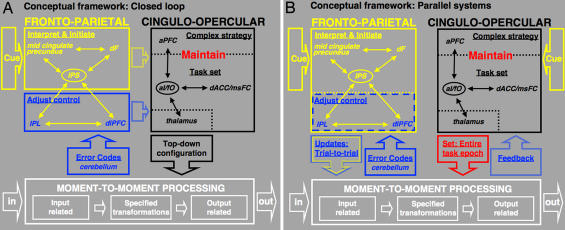Fig. 4.
Dual-network hypothesis of task control. Thin arrows schematize strong functional connections, ovals schematize hubs, and thick arrows schematize putative flow of information. (A) Information may flow between the frontoparietal and cinguloopercular networks, such that the stable control network receives control initiation signals from the adaptive control network at the beginning of a task period, as well as adjustment signals during task performance. (B) Alternatively, the frontoparietal and cinguloopercular control networks may be organized in parallel. Both networks might interpret cues, implement top–down control, and process bottom–up feedback. The frontoparietal network may adjust task control on a trial-by-trial basis, whereas the cinguloopercular network might affect downstream processing in a more stable fashion. Frameworks intermediate between A and B are also consistent with the data.

